By special guest contributor Marc Lissenburg
“What’s the scariest film you’ve ever seen?” It’s a query I am faced with on an alarmingly regular basis when folk learn of my fervent horror movie fanaticism. Despite the somewhat tedious probing, my enthused and instantaneous retort each time is – “THE EXORCIST!”
Now I accept one man’s ‘classic’ (Kermode) is another man’s ‘crap’ (LaVey) and, as such, have no intention of reigniting that particular debate with this article. I will, however, afford myself a little subjective self indulgence simply to convey the motivation for penning this piece.
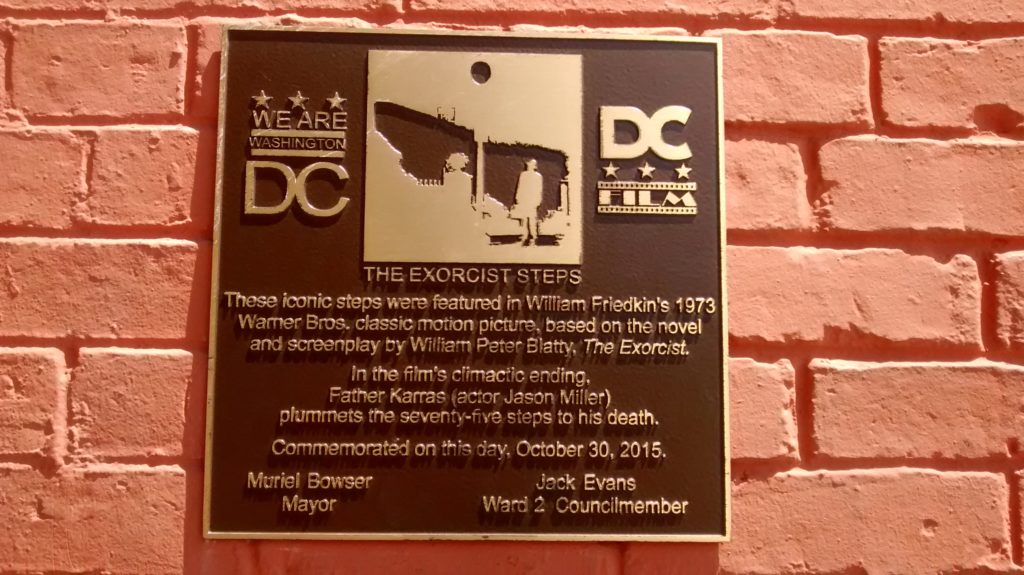 I first watched The Exorcist aged 14, a couple of years before it was withdrawn from UK home video circulation after being refused an 18 certificate under the 1984 Video Recordings Act. Its esteemed director, William Friedkin, has been forthright in claiming he intended the film to be an “emotional experience”. That concise précis perfectly describes my personal attachment to the picture, for numerous reasons. You see, up until viewing The Exorcist, my horror edification had largely been through gore-tinted glasses as I indulged in Video Nasty culture on VHS. But just a few minutes into Friedkin’s masterpiece, I was overcome with the sense I was watching a ‘serious horror film’.
I first watched The Exorcist aged 14, a couple of years before it was withdrawn from UK home video circulation after being refused an 18 certificate under the 1984 Video Recordings Act. Its esteemed director, William Friedkin, has been forthright in claiming he intended the film to be an “emotional experience”. That concise précis perfectly describes my personal attachment to the picture, for numerous reasons. You see, up until viewing The Exorcist, my horror edification had largely been through gore-tinted glasses as I indulged in Video Nasty culture on VHS. But just a few minutes into Friedkin’s masterpiece, I was overcome with the sense I was watching a ‘serious horror film’.
My inaugural viewing as a teenager enticed me to understandably bask in the tremendously profane blasphemy on offer. Along with this, the notion that an innocent 12 year old girl being used as a mere vessel by Pazuzu implied possession could happen to anyone. The concept sent shrills down my pubescent spine. Then there was my ill-fated Catholic upbringing. The obnoxious nurturing ultimately accelerated my journey toward Satanic freedom, or at the very least, “faithless slime” as Regan so eloquently put it. Either way, it undoubtedly increased the potency of the movie’s vital religious element.
But it was the film’s location of Georgetown that fascinated me. Having family that reside in Washington DC, it seemed sacrilege not to make the unholy pilgrimage t0 the landmarks immortalised in Friedkin’s menacing picture. 31 years after my initial viewing, I finally trekked over the Potomac Bridge to what I consider the Mecca of horror locations….
Having a cousin that graduated in Georgetown as a personal tour guide certainly helped. I was in awe of her intricate knowledge of the area, yet openly chastised her for never watching the movie itself. The first thing that struck me about the district situated in the Northwest of Washington DC was an enthralling sense of historic charisma. Cobbled sidewalks complemented by processions of thriving trees dwelled harmoniously among antique constructions. The meld offered a unique balance of homely neighbourhood and enigmatic tradition.
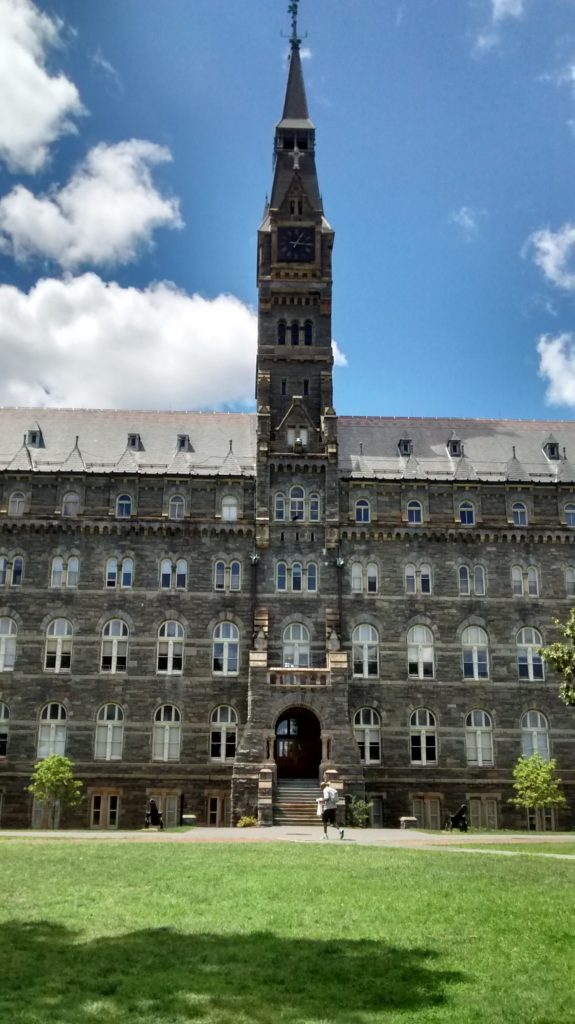 Before long, the almost regal facade of the Georgetown University Campus stood proudly before me. Its Georgian brick architecture and proud steeple seemed to radiate a sense of history. Originally a Jesuit private university when founded in 1789, the structural design has remained intact despite the proud evolution of the buildings’ function. The campus site is of course briefly featured in the ‘movie within the movie’ sequence that serves to establish Chris MacNeil and Burke Denning’s characters and relationship. The liberal grassy zones in front of the eminent structure were now patently evident, as opposed to being crowded with the ‘demonstrating public’ in the movies preliminaries.
Before long, the almost regal facade of the Georgetown University Campus stood proudly before me. Its Georgian brick architecture and proud steeple seemed to radiate a sense of history. Originally a Jesuit private university when founded in 1789, the structural design has remained intact despite the proud evolution of the buildings’ function. The campus site is of course briefly featured in the ‘movie within the movie’ sequence that serves to establish Chris MacNeil and Burke Denning’s characters and relationship. The liberal grassy zones in front of the eminent structure were now patently evident, as opposed to being crowded with the ‘demonstrating public’ in the movies preliminaries.
The main arched entrance exemplified the grandiosity of the building by appearing to swell in size as I approached it. A scaling stone stairway ushered me to the inspiring Georgetown Seal mosaic floor motif which sat before the double door entrance.
Although not featured in the movie, the mythical significance of the design is such I felt it was worth mentioning. You see, legend has it that if you set foot on the seal, you will not graduate in 4 years’ time. Despite this alleged myth being completely irrelevant to a tourist such as me, something made me respectfully sidestep the section as I entered the illustrious building. This act, I was assured, is replicated by the mass of students who onerously side-step the design, even during rush hour!
A dissecting walk through the impressive Healy Hall led us to the tranquil setting that is known as the Dahlgren Quadrangle. Before us stood the Dahlgren Chapel of the Sacred Heart. Crowned on the University’s website as the “spiritual heart of the Georgetown community”, the Catholic chapel is in fact a century younger then the Campus that encircles it.
Despite ‘St Mikes’ (the place of worship’s appellation in the film) only being afforded a few seconds of screen time, I found its exterior instantly recognisable. Made up of lustrous brickwork housing the Celtic styled window arch that leads toward the solitary bell and crucifix at its summit, the location remains identical to its depiction on celluloid 44 years previously.
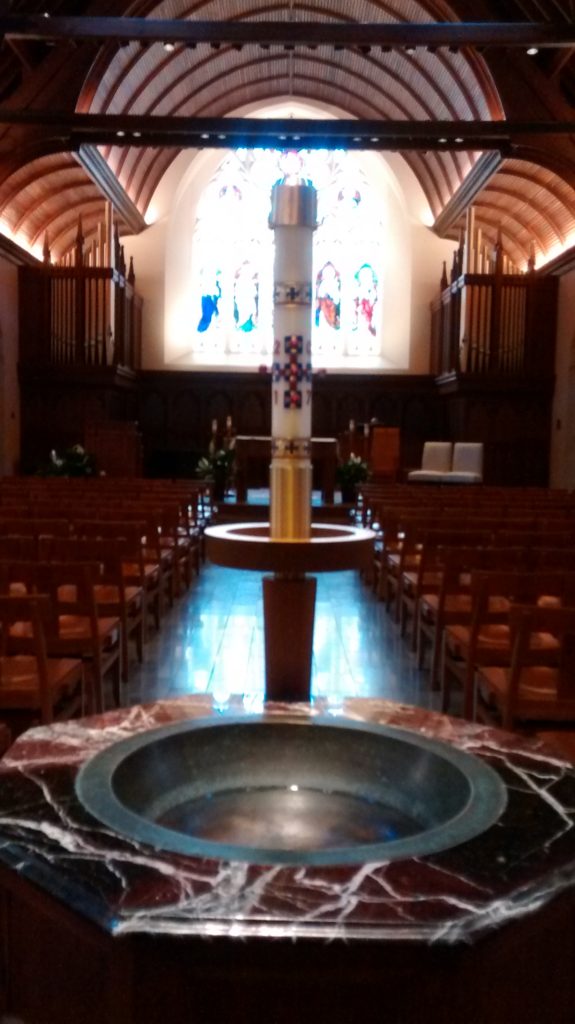 Despite the overtly sanctified status of the edifice, I was saturated with blasphemous cravings when I entered the vestibule. I couldn’t refrain from polluting the serene atmosphere with a puerile demonically whispered “it burns” as I placed my hand in the font of ‘holy water’, much to the embarrassment of my younger, yet considerably more mature cousin. Then I caught sight of the pristine foliage meticulously positioned either side of the altar. It evoked that shocking scene whereby a priest’s attempt to carry out his duty of placing flowers at the chapel’s centre is infamously interrupted by the odious desecration of a holy statue.
Despite the overtly sanctified status of the edifice, I was saturated with blasphemous cravings when I entered the vestibule. I couldn’t refrain from polluting the serene atmosphere with a puerile demonically whispered “it burns” as I placed my hand in the font of ‘holy water’, much to the embarrassment of my younger, yet considerably more mature cousin. Then I caught sight of the pristine foliage meticulously positioned either side of the altar. It evoked that shocking scene whereby a priest’s attempt to carry out his duty of placing flowers at the chapel’s centre is infamously interrupted by the odious desecration of a holy statue.
The somewhat garish 1970s chic of the chapel’s interior in the movies’ scenes where Father Karris conducts a Catholic mass, gives way to more traditionally serene surroundings in the present day. Absent is the crimson carpet that flowed toward the altar for example. The arched designs carved into wood took on a near luminescent glow behind the troubled priest in the film. Today however, possibly due to a few conservative coats of varnish, the wood takes on a darker, more subtle guise.
Just above these carved designs are a quintuple of stained glass windows. We only get a teasing glimpse showing the bottom edges of the in the movie’s aforesaid church scenes. It is very evident, though, that the embellished glasswork predictably remains respectfully identical today. Resisting Pazuzu’s attempts to guide my hand in the act of writing some profane demonic quote in the Chapel Book of Prayer Intentions, we took the short stroll to 3600 Prospect Street.
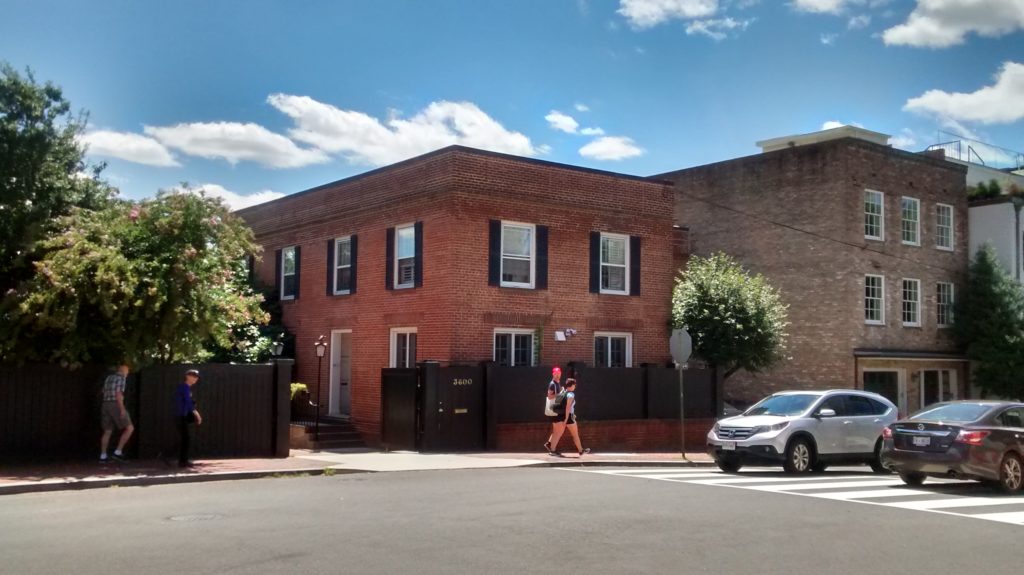 Obviously this is the property frequently referred to as the “Exorcist House” due to its portrayal as the MacNeil residence in the movie. The distinctive black metal railings that separated the property from the sidewalk have been predictably forfeited in favour of a solid wood privacy fence, no doubt due to pesky groupies such as myself. By some good fortune however, the large solid wood gates were generously left open on the afternoon of our visit granting us the voyeuristic delicacy of being able to ogle the house’s fascia. The ajar front door conjured images of Karl carrying a comatose and blanketed Regan from the 1972 Mercedes 280SE into the house. While ingesting the honour of being confronted with the most iconic residence in horror history, visions of Regan saying goodbye to Father Dyer in the movies closing scenes washed over me. What enriched the experience was just how similar the site appeared. There was simply no need to decipher our location. Bar the aforementioned fencing, everything was seemingly unaffected by the claws of time. Even the duet of lamp posts, both capped with metallic flying birds, remained proudly guarding the house’s entrance. There was of course one last site to behold on our tour of terror – The legendary “Exorcist M Street steps” themselves…
Obviously this is the property frequently referred to as the “Exorcist House” due to its portrayal as the MacNeil residence in the movie. The distinctive black metal railings that separated the property from the sidewalk have been predictably forfeited in favour of a solid wood privacy fence, no doubt due to pesky groupies such as myself. By some good fortune however, the large solid wood gates were generously left open on the afternoon of our visit granting us the voyeuristic delicacy of being able to ogle the house’s fascia. The ajar front door conjured images of Karl carrying a comatose and blanketed Regan from the 1972 Mercedes 280SE into the house. While ingesting the honour of being confronted with the most iconic residence in horror history, visions of Regan saying goodbye to Father Dyer in the movies closing scenes washed over me. What enriched the experience was just how similar the site appeared. There was simply no need to decipher our location. Bar the aforementioned fencing, everything was seemingly unaffected by the claws of time. Even the duet of lamp posts, both capped with metallic flying birds, remained proudly guarding the house’s entrance. There was of course one last site to behold on our tour of terror – The legendary “Exorcist M Street steps” themselves…
Watching the movie again recently, it’s notable just how little screen time the unwittingly sinister set of steps is given. The fatal climactic plummet of Father Karris naturally imbued them with notoriety. But it’s two other wonderfully photographed scenes that put the landmark in the limelight. Firstly, there is Lieutenant Kinderman’s inquisitive ascending gaze as he ponders Burke Denning’s ungodly demise. Then in the film’s closing frames, we witness Father Dyer’s solemn and regretful look downward.
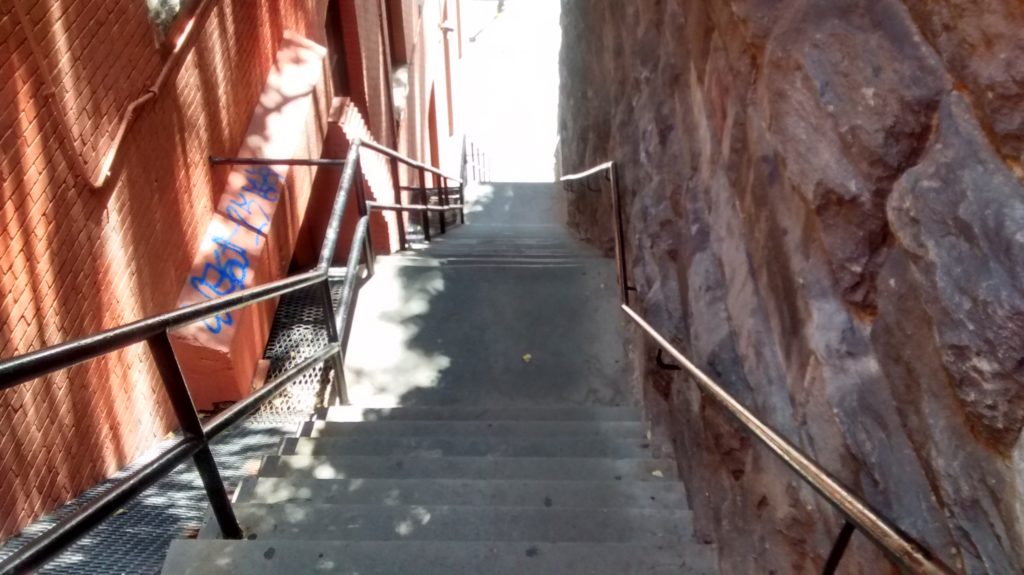 The concrete staircase is offset from the house and it’s a renowned fact that an extension was temporarily built onto 3600 Prospect Street to give the impression that Regan’s bedroom indeed lingered above the 75 steps. Surveying the palpably steep descent from the landmark’s apex, I was instantly struck with just how impressive the stuntman’s plunge was, considering the precipitous concrete was only mitigated by a mere half inch of rubber at the time of filming.
The concrete staircase is offset from the house and it’s a renowned fact that an extension was temporarily built onto 3600 Prospect Street to give the impression that Regan’s bedroom indeed lingered above the 75 steps. Surveying the palpably steep descent from the landmark’s apex, I was instantly struck with just how impressive the stuntman’s plunge was, considering the precipitous concrete was only mitigated by a mere half inch of rubber at the time of filming.
I cautiously negotiated the flight of steps ensuring I suffered no such fate as the collared protagonist. The landmark was officially made a tourist attraction in a Halloween ceremony attended by creators William Peter Blatty and William Friedkin in 2015, an honour confirmed by the handsome plaque on the wall at the base.
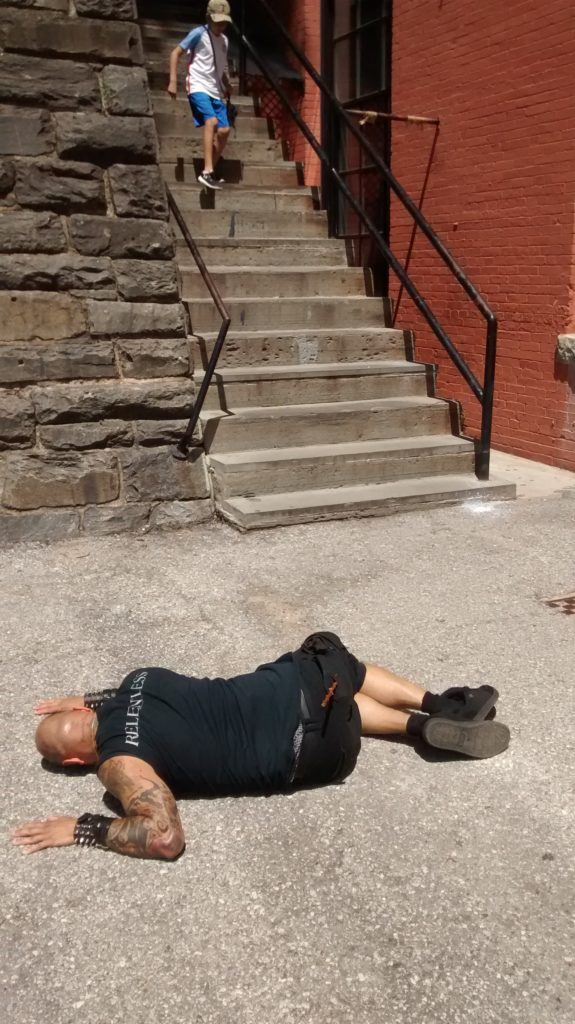 Scrutinizing scenes in the film where the stairwell featured, I noticed the scarlet word “PIGS” apparently sprayed onto the wall just over the stairs railings. This had now been replaced by unreadable blue graffiti. The same ‘artist’ had seemingly added the obligatory “Fuck Trump” protest to the tourist attraction! The climb upward obviously proved more arduous, and after a few circuits causing my leg muscles to smoulder, I knew it was time to bid farewell. I did however manage to persuade my cousin to capture me in “Karris pose” laying face down on the pavement at the stairs base.
Scrutinizing scenes in the film where the stairwell featured, I noticed the scarlet word “PIGS” apparently sprayed onto the wall just over the stairs railings. This had now been replaced by unreadable blue graffiti. The same ‘artist’ had seemingly added the obligatory “Fuck Trump” protest to the tourist attraction! The climb upward obviously proved more arduous, and after a few circuits causing my leg muscles to smoulder, I knew it was time to bid farewell. I did however manage to persuade my cousin to capture me in “Karris pose” laying face down on the pavement at the stairs base.
I was previously a bit torn about horror locations. For every Oakley Court there is a site that has been renovated to the point of it being completely unrecognisable from the movie it originally featured in. But my Georgetown experience has certainly given me the bug. Next stop, southern Germany for all things Suspiria….!
